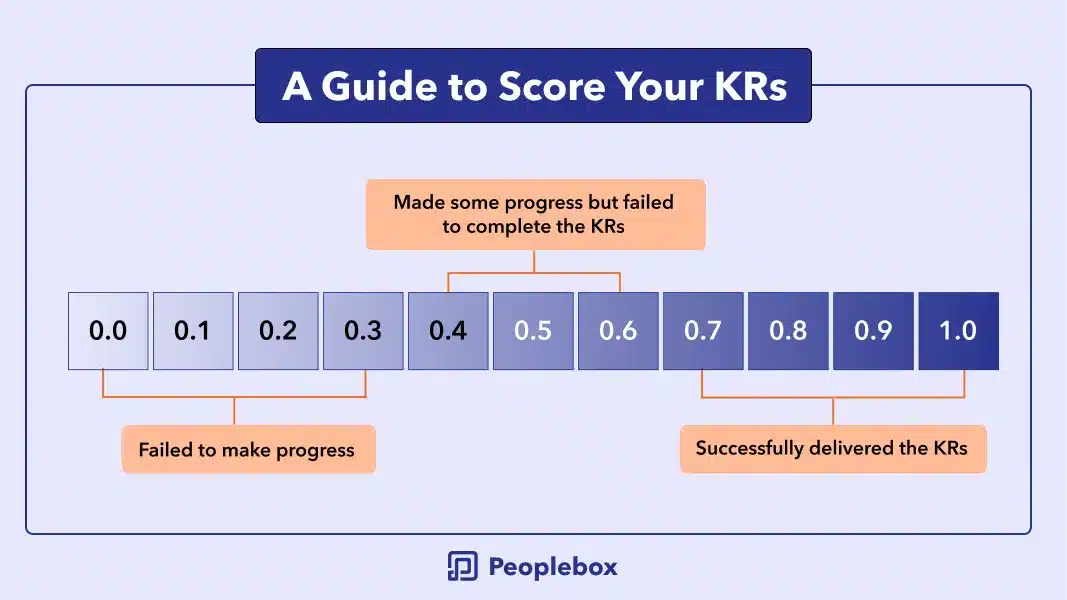What if you could reach your goals with less effort and more precision?
What if you had a system for goal-setting that was used by some of the most successful companies in the world?
Well, achieving your goals can be a struggle, but OKRs make it easier, don’t they? Adopted by powerhouses like Google, Intel, and LinkedIn, we know this framework is very potent for setting objectives.
However, it’s not enough to simply set OKRs – you need to measure and track your progress towards them. This is where an effective OKR scoring system comes in. By measuring and scoring your progress against each OKR, you can gain valuable insights into what’s working, what’s not and where you need to focus your efforts to drive success.
In this comprehensive guide, we will explore how to build an effective OKR scoring system that will help you measure the effectiveness of your OKRs and drive real progress towards your goals. So, let’s dive in and get started!
What is OKR Scoring?
OKR scoring is a method used to measure progress and track its effectiveness in achieving desired outcomes. In an OKR scoring system, each objective and key result is assigned a score based on the level of progress made towards achieving it. While the scoring system typically uses a scale of 0-1.0, with 1.0 representing the achievement of the objective or key result. There are other methods as well which we will discuss shortly.
Benefits of scoring OKRs
The purpose of OKR scoring is to provide a clear and objective way to track progress towards goals, identify areas that require more attention, and evaluate the effectiveness of the OKRs in driving desired outcomes. With an effective OKR scoring system in place, organizations can make informed decisions about how to allocate resources and adjust their strategies to optimize performance and drive success.
The benefits you get with scoring OKRs are:
Easy tracking: An effective scoring system makes it easy to track progress towards each OKR, providing a clear view of how well the system is doing.
Clear targets: By assigning a specific numerical score or target to each objective and key result, you can clearly define what success looks like and what needs to be achieved.
Accountability: Scoring OKRs helps to hold individuals and teams accountable for achieving their goals, as progress is measured objectively and transparently.
Enhanced alignment: Scoring OKRs helps to align individual and team efforts with organizational goals and objectives, ensuring everyone is working towards the same targets and has clarity of what needs to be achieved.
Enhanced motivation: Humans are most motivated when they see their work making a difference. Seeing progress towards objectives and key results can be highly motivating, specially when scores are visible to others and tied to rewards and recognition.
Insight into required improvements: Scoring OKRs provides valuable insights into areas that require more attention or improvement as you can see progress. It also enables organizations to make data-driven decisions and adjust strategies as needed.
How to Score OKRs [+ Examples]?
1. Traditional Binary Scoring
Traditional binary OKR scoring is a straightforward approach to measuring progress towards objectives and key results. It is based on a binary scoring system, which means that each OKR is either achieved or not.
One advantage of this binary scoring system is that it is easy to understand and implement. It provides a clear indication of whether an OKR has been achieved or not, with no grey areas or ambiguity. This simplicity can be beneficial for organizations new to the OKR framework, as it helps them to get started quickly and with minimal confusion.
However binary scoring has its limitations. It doesn’t allow for nuanced measurements of progress, as it only indicates whether something has been achieved or not. This can be demotivating for individuals and teams who may be making progress towards an OKR but not quite achieving it in its entirety. It can be demotivating for employees who worked hard and showed growth but failed to achieve the set targets.
2. Google-styled scoring– 0-1
This method is named Google-styled scoring because Google uses this grading style and is now a widely used grading system for OKRs. In this method, OKRs are typically graded on a scale, which ranges from 0.0 to 1.0, where 1.0 represents complete achievement. The progress along the scale is indicated by increments. This method provides a simple and transparent way to evaluate the success of each OKR.
In this method, key results are graded individually, the average of which is used to grade the objective. Key results are weighted based on their importance to the objective.
To track progress, it’s ideal to grade key results regularly throughout the cadence period, which is typically a quarter. Here’s how this OKR grading works:
- Each objective is assigned a score of 0.0 to 1.0, based on how well it was achieved. A score of 0.0 means that the objective was not achieved at all, while a score of 1.0 means that the objective was fully achieved.
- Each key result is also assigned a score of 0.0 to 1.0, based on how well it contributed to the achievement of the objective it was associated with. Again, a score of 0.0 means that the key result did not contribute at all, while a score of 1.0 means that the key result fully contributed.
- To calculate the overall score for an objective, take the average of all the key result scores associated with that objective. This provides an objective-level score that reflects the overall success of the objective.
- To calculate the overall score for a set of OKRs, take the average of all the objective-level scores. This provides a single score that reflects the overall success of the OKRs.
This can also be your guide to scoring your KRs

For example:
Objective: Increase revenue from online sales by 20% in Q2
Key Result 1: Achieve $1 million in online sales in Q2
KR 2: Increase website traffic by 25%
KR 3: Improve conversion rate to 5%
Scoring for KR 1 will look something like this:
- 0.0: Less than $500k
- 0.4: $500k – $800k
- 0.7: $800k – $999k
- 1.0: $1m or more
Scoring for KR 2: Increase website traffic by 25%
- 0.0: Less than 10% increase
- 0.3: 10% – 15% increase
- 0.7: 16% – 20% increase
- 1.0: 25% or more
Scoring for KR 3: Improve conversion rate to 5%
- 0.0: Less than 3%
- 0.3: 3% – 4%
- 0.7: 4.1% – 4.9%
- 1.0: 5% or more
Let’s assume the teams achieved the following scores:
KR1: $1m – $1.19m = 0.7
KR2: 16% – 20% increase = 0.7
KR3: 4.1% – 4.9% = 0.7
The overall score will be the average of all 3 KRs: 0.7 + 0.7 + 0.7 / 3 = 0.7
This means that the team achieved a score of 0.7, indicating that they made good progress towards the objective but didn’t quite hit all of the key results.
3. Value-based key result scoring
Value-based KR scoring is a method of measuring the success of OKRs based on their contribution to delivering value to the organization. Value-based scoring measures the outcomes of successful activities and is aligned with the organization’s values. The KRs that are measured in the value-based scoring are gauged based on the value it delivers.
By adopting value-based OKR scoring, companies can focus on outcomes and not only on activities. A KR as such will be measurable, time-bound, and achievable, making it easier for companies to track their progress and measure the success of their OKRs. Most companies use a tool for this scoring method because it becomes easy to measure the progress using the app features.
For example:
- Increase Net sales from X to Y.
- Maintain Customer Acquisition cost under Y.
- Improve average weekly visits per active user from X to Y.
- Increase non-paid (organic) traffic from X to Y.
- Improve engagement (users that complete a full profile) from X to Y.
In this method, X is the baseline and Y represents the target. This method conveys more information about the progress than a percentage method by setting a clear baseline to start with and quantifiable targets.
- Increase net sales from $ 1 million to $ 2 million
- Increase sales by 20%
In the above example, you can clearly see the progress in the sales number and know how much you need to achieve while the 20% target creates an ambiguity of the exact number to be achieved.
4. Grading by Key Results
Grading OKRs by key results is a method that allows organizations to evaluate the progress and success of their OKRs based on the degree of completion of individual key results. This method combines traditional binary scoring and Google-styled scoring. With this method, each key result is assigned a specific grading scale, which can range from 0 to 1 or 0 to 100%, to measure the progress made towards achieving that particular key result.
For example:
Objective: Increase website traffic by 20% in Q3
KR1: Increase organic traffic by 15%
KR2: Increase the percentage of positive feedback from customer surveys by 5%
Objective: Launch a new product by the end of the quarter
KR3: Complete new product feature design and testing
KR4: Finalize pricing strategy
In the above examples, the first two key results are measurable and can be measured using a scale. While the last two key results are binary and either be completed or not.
5. Predictive Scoring
Unlike traditional OKR scoring, which evaluates the success of an objective based on whether or not it was achieved, predictive scoring takes into account the team’s confidence in achieving the objective at the start of the quarter, as well as their confidence as they progress and receive new data.
For example:
The team sets OKRs and feels 50% confident in achieving them at the start of the quarter. As they make progress towards these objectives and receive new information, they continue to rate their confidence levels. This predictive scoring approach allows teams to take a more nuanced and adaptive approach to achieve their OKRs.
If the team’s confidence level and percentage increase throughout the quarter, this is a sign that the team is making progress towards achieving the objectives. On the other hand, if the team’s confidence level decreases or remains low, this is a warning sign that the objectives are at risk, and team members need to reassess their initiatives.
6. No Grade
The no-grade approach to OKR scoring is a straightforward method that avoids the complexities of assigning numerical scores to key results. Instead of assigning grades, the focus is on measuring the progress towards achieving the objectives using built-in measurement systems. This approach is particularly useful for smaller organizations that may not have the time or resources to track and evaluate multiple metrics.
For example:
Increase website traffic by 30%
Instead of assigning a specific grade or score to this key result, you could simply track the percentage increase in website traffic over the quarter. You can use tools like Google Analytics to measure traffic and see if you achieved your target.
Or if your objective is to launch a new product, your key results could include tasks like creating a product roadmap, developing a marketing plan, and conducting customer research. Instead of grading these key results, you could simply track the completion of these tasks and the progress towards launching the product.
Things to Consider When Grading OKRs
OKRs are an effective tool for organizations to set and achieve their goals. However, grading these OKRs can be a tricky task. Here are some things to consider when grading OKRs:
1. Setting an ideal range for defining success
It is crucial to set an ideal range for defining success when grading OKRs. The ideal range is usually around 60-70% for most organizations. This is also the ideal set by Google to measure the success of its OKRs. If you set the bar too high, it may discourage employees, and if you set it too low, it may not challenge them enough.
2. Grading company OKRs publicly
Grading company OKRs publicly can create transparency and accountability among team members. It also helps to identify areas of improvement and celebrate successes. However, it’s important to balance transparency with privacy concerns and avoid creating a culture of blame or shame. Google shares the performance of the previous year’s OKR and the new OKRs in a company-wide meeting.
3. Quarterly and mid-quarterly Check-ins
It is essential to check in on OKRs mid-quarter to monitor progress and make necessary adjustments before the final grading. This allows employees to receive feedback on their progress, access where they are and adjust their strategies if needed.
4. Keeping performance evaluation and OKRs separate
OKRs should be used to drive progress towards specific goals, while performance evaluations should be used to assess an employee’s overall job performance. Achievement of OKRs should not be used as a metric of performance. Separating these two processes can help ensure a fair evaluation.
5. Subjectivity in scoring
OKR scoring can be subjective, and there may be different interpretations of what constitutes success. It’s essential to have clear guidelines and communication to ensure that everyone understands how the OKRs will be scored. There may be times when the teams put in full effort and yet fail to achieve the OKR. It does not mean a complete failure. Instead, consider the impact of the outcomes on the organization.
Challenges and Pitfalls to Avoid
While OKRs are powerful tools for organizations to align their teams towards common goals, there are challenges and pitfalls that you should be aware of when implementing this approach.
1. Frustration when OKRs are not achieved
One of the main challenges is the frustration that can arise when OKRs are not achieved. This can be demotivating for employees and teams, particularly if the failure is attributed to factors beyond their control. To avoid this, it is important to set realistic goals and provide regular feedback and support to help employees and teams stay on track.
2. Disconnect in OKR scoring and OKR achievement
Another pitfall is a disconnect between OKR scoring and OKR achievement. It is important to ensure that the metrics used to grade the achievement of key results are directly linked to the objectives set. This will ensure that teams remain focused on the desired outcomes and are not distracted by irrelevant metrics.
3. Losing sight of the big picture when focusing on KR
A common pitfall is losing sight of the big picture when focusing on key results. While key results are important indicators of progress towards objectives, it is essential to keep the broader context in mind. Teams should be encouraged to think creatively about how they can achieve objectives, rather than just ticking off key results.
4. Subjectivity difference
Subjectivity in scoring can also be a challenge. Different managers or teams may have different interpretations of what constitutes success, which can lead to inconsistencies in grading. To avoid this, it is important to establish clear guidelines for grading and provide training and support to ensure that everyone is aligned on what success looks like.
Conclusion
Implementing an OKR scoring system is essential for any organization to achieve its goals effectively. It helps in identifying areas for improvement, measuring progress, and staying accountable.
By considering the factors mentioned in this blog, such as setting ideal success ranges, quarterly check-ins, and keeping performance evaluations separate, you can develop a reliable and effective OKR scoring system.
Using tools like Peoplebox can simplify the process, making it easier for you to monitor and track progress regularly. So, don’t wait any longer, book a demo today to simplify your OKR implementation and scoring process.







